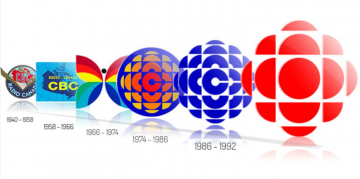A Virtual Third Place: The Canadian Broadcasting Corporation / Société Radio-Canada.
On November 2, 1936, Canada’s federal government under Prime Minister Richard Bennett created the Canadian Broadcasting Corporation / Société Radio-Canada, a Crown-owned media corporation.
The CBC commenced radio broadcasts later that year, followed by television broadcasts in 1952. The decision to institute a public broadcasting service was twofold: firstly, to counter the influence of American broadcasts, a motive that remains to this day, and secondly, to help Canadians stay informed and in touch across the country’s vast geography. By way of transmission on radio waves accessible to Canadians using electrical devices, this country established a technological public space, something we would call in today’s vernacular a “virtual” third place – read more about “the third place” below.

L’évolution de l’identité visuelle de CBC / ICI Radio-Canada de 1940 à nos jours.
Photo: Radio-Canada
Since its inception, CBC/Radio-Canada has been a leading provider of national and international news and cultural, educational, and informational programming, including long-running series such as The Nature of Things, Quirks and Quarks, Ideas, Marketplace, and the fifth estate. In recent years, as new technologies have influenced the way people access programming, changes to formatting and delivery have been necessary to maintain the CBC’s audience numbers (McGuire, 2009). Those changes include the addition of a web-based resource called CBC Curio.ca.
Curio.ca is CBC’s educational streaming subscription service. Available on the site are stories from the English television news broadcast, The National, and its French counterpart, Le téléjournal, as well as segments from national and local radio news and feature episodes from regular television broadcasts. Curio.ca also hosts arts and entertainment programming, including performances from the Stratford Festival, CBC/Radio-Canada drama and comedy programs, and a range of children’s programming.
UBC students, faculty, staff, and on-site Library users have access to Curio.ca’s thousands of television shows and radio programs as well as teacher guides and K–12 curriculum connections. Available in both English and French, the programs and teacher guides cover a wide range of topics suitable for all ages. Although UBC doesn’t currently have access to the BBC and National Geographic content, Curio.ca remains a superb resource for complementing and extending lesson activities and assignments.
“Information flows freely and rapidly across borders, creating instant access to international news events. For global literacy to become integral to the [school] experience, [educators] must discover ways to make it relevant in the classroom.” (Petrausch, 2005, p. 5)
Create, Make, Innovate: Getting Hands-on with Learning Design
Recap of the session in the Scarfe Foyer in the Fall of 2019:
At this week’s Create, Make, Innovate! activity session, on Tuesday, October 15th, 2019, teacher candidates (TCs) explored the on-line planning resource, CBC Curio.ca.
Thanks to some interactive facilitation by Graduate Academic Assistant, Jennifer Abel, and Education Librarian, Wendy Traas, TCs were led through some guided browsing of the Curio.ca collection. Using the site’s quick navigation search tool, they were able to see and assess for themselves the various programming resources and curricular guides that are available. These guides make use of existing provincial curricula, making them more immediately applicable than a more generic teacher guide might be.

Downloadable image available from https://www.cbc.ca/curiopromokit/creative-assets
Navigating through the Curio.ca resources is similar to searching the Scarfe Digital Sandbox. A diverse selection of programming can be searched by category, age group, language (English or French), or subject. Toolbar headings and sub-headings arrange various “collections” of programming and resources into different “categories.” These identifiers overlap, which makes for more thorough searches that turn up specific results each time. Although this means that search results eventually grow repetitive, the Curio catalogue goes back a long way – English content dates back to the 1960s and French back to the 1940s, which is nearly back to the beginning of CBC/Radio-Canada!
“Curio.ca gives teachers and students streaming access to the best in educational video and audio from CBC and Radio-Canada. You’ll find documentaries from television and radio, news reports, and more…”
– from CBC Curio.ca
Resources
One issue-driven collection in the Curio.ca resources is called “Fake News and Misinformation,” which offers a series of sub-topics, e.g. Bias and Reliability, Disinformation and Lies, Safeguarding Social Media, each with its own catalogue of short, informative video features and news reports. By selecting several videos, perhaps in concert with an historical article from The New York Review of Books, an international study on addressing the spread of misinformation, and a report from the Pew Research Center, a Secondary teacher or a group of teachers could have the makings of a robust unit plan, addressing concerns as well as responses to the issue of fake news.
In a related story, there’s potential for an interdisciplinary investigation by “combining the expertise of both the social sciences and computer science” into an automated analysis that can help “news aggregators to detect and visualize the occurrence of potential media bias in real time” (Hamborg, Donnay, & Gipp, 2018).
Finally, based on Wilhite’s (2015) fascinating interdisciplinary study of how reporting style itself influences news audiences, students and teachers might even decide to practise applying their evaluative skills while using the Curio.ca site, itself.
For a look into our country’s cultural and media history, or for some rich lesson planning ideas, check out Canada’s very own trustworthy on-line public news resource, CBC Curio.ca.
More about “The Third Place”
Have you ever heard of Ray Oldenburg and the Third Place?
No, it’s not a music venue or public house although you’re on the right track.
Oldenburg was an American sociologist who proposed the idea that we spend our lives in cultural “places,” the “first” being home, the “second” being work, and the “third” – no less significant – comprising various public venues where we come together and share company. Today, these might be plazas and high streets, where cafés, pubs, markets, salons, and all variety of hangouts and community centres line the sidewalks. According to Oldenburg, this third place and its togetherness are vital to sustaining a healthy democracy.
Cultural practice of the Third Place concept traces a long, absorbing history. In Ancient Greece, the agora was a city-state’s literal “gathering place,” where spiritual, cultural, political, and even military circles conjoined. Much later, in the 15th century, Islamic culture introduced a smaller but equally potent space, the coffee-house, which spread from the Arabian peninsula to Istanbul and beyond, to places as far away as Venice, Oxford, and London. Among its many social functions, the coffee-house became an interdisciplinary centre, a hub for cultural debates, news reports, and the general exchange of information between people from uncommon walks of life and status, all taking place in an atmosphere far less formal than a university, trade centre, or government house (White, 2018).

“A Coffee House in the Time of Charles II
From a wood cut of 1674” (Ukers, 1922, p. 60)
Today, a common comparison of the coffee-house is made to social media. The analogy is apt: Pew Research Center recently reported that “those who use social media… are more regularly exposed to people who have different backgrounds and more connected with friends they don’t see in person.” Pew also reported that, at the outset of the 21st century, “digital platforms [played] a larger role in news consumption, and… [seemed] to be more than making up for modest declines in the audience for traditional [primarily physical print] platforms” (p. 1). Furthermore, the influence of social media and search engines had made peoples’ news gathering and consumption habits more intermittent.
Certainly, apps and platforms like Instagram, Twitter, Snapchat, and Facebook play with Oldenburg’s concept of the Third Place in ways that denizens of the coffee-house might have appreciated today yet could not have imagined in their time. For its dearth of in-person contact, arguably its fundamental feature, social media’s once-removed stance is also critiqued as an insidious pitfall. Where a coffee-houser had as much assurance as we do that what they learned might be true, they were linked neither instantaneously nor indiscriminately to all other coffee-housers simultaneously but sat face to face across from only those with whom they spoke. Such is the potential of the Third Place on-line today, that our interaction with social media might actually serve to undermine us, unless we take active and careful precaution.
Read more from Royal Roads University about how young people engage with politics via social media, and about the role that social media plays in politics within smaller communities.
Acknowledgement: post author, Scott Robertson; editor, Yvonne Dawydiak
Interdisciplinarity, collaboration, hands-on learning – that’s the spirit of Create, Make, Innovate! We want to promote enthusiasm for sharing and learning across age groups and across subject disciplines.
Make, Create, Innovate sessions took place during the Fall 2019 in the foyer of the Neville B. Scarfe building and were hosted by Scott Robertson, a project assistant on a small TLEF grant with Dr. Lorrie Miller, Dr. Marina-Milner Bolotin and Yvonne Dawydiak, Teacher Education.
If you have an idea or an inspiration for a resource or future session, please let us know! scarfe.sandbox@ubc.ca
References
Hamborg, F., Donnay, K., & Gipp, B. (2018, November). Automated identification of media bias in news articles: An interdisciplinary literature review. International Journal on Digital Libraries, 1–25. https://doi.org/10.1007/s00799-018-0261-y
McGuire, Jennifer. (2009). “Biggest change in history of CBC News: What it means to you”. Cbc.ca. Last updated October 26, 2009. Retrieved October 2, 2019 from https://www.cbc.ca/news/canada/biggest-change-in-history-of-cbc-news-what-it-means-to-you-1.864143
Petrausch, R. J. (2005). Five strategic imperatives for interdisciplinary study in mass communications / media studies in the U.S. and U.K. International College Teaching Methods & Styles Journal, 1(3), 1–10.
Ukers, W. H. (1922). All about coffee. New York, NY: The Tea and Coffee Trade Journal Company. https://archive.org/stream/allaboutcoffee00ukeruoft#mode/1up
White, M. (2018, June 21). Newspapers, gossip, and coffee-house culture. Retrieved from https://www.bl.uk/restoration-18th-century-literature/articles/newspapers-gossip-and-coffee-house-culture
Wilhite, C. J. (2015). Mass news media and American culture: An interdisciplinary approach. Behavior and Social Issues, 24, 88–110. doi: 10.5210/bsi.v.24i0.5004
Many thanks to Jennifer Abel for helping contribute to this week’s blog entry as well as facilitating the activity session!

